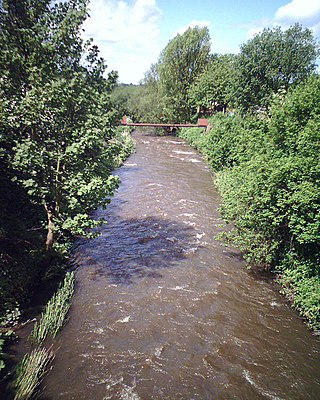
The River Douglas, also known as the River Asland or Astland, flows through parts of Lancashire and Greater Manchester in North West England. It is a tributary of the River Ribble and has several tributaries, the major ones being the River Tawd and the River Yarrow.

Edwinstowe is a large village and civil parish in the Newark and Sherwood district of Nottinghamshire, England, on the edge of Sherwood Forest. It is associated with the legends of Robin Hood and Maid Marian and known for the proximity of the former Thoresby Colliery. The civil parish population at the 2011 census was 5,188. A 2019 estimate put it at 5,261.

Baron Hesketh, of Hesketh in the County Palatine of Lancaster, is a title in the Peerage of the United Kingdom. It was created in 1935 for Sir Thomas Fermor-Hesketh, 8th Baronet, who had previously briefly represented Enfield in the House of Commons as a Conservative. As of 2010 the titles are held by his grandson, the third Baron, who succeeded his father in 1955. Lord Hesketh held junior ministerial positions in the Conservative administrations of Margaret Thatcher and John Major. However, he lost his seat in the House of Lords after the House of Lords Act 1999 removed the automatic right of hereditary peers to sit in the upper chamber of Parliament.

Baron Savile, of Rufford in the County of Nottingham, is a title in the Peerage of the United Kingdom. It was created in 1888 for the diplomat Sir John Savile. He was the eldest of the five illegitimate children of John Lumley-Savile, 8th Earl of Scarbrough, and the grandson of John Lumley-Savile, 7th Earl of Scarbrough. The latter was the fourth of the seven sons of Richard Lumley-Saunderson, 4th Earl of Scarbrough, and his wife Barbara, sister and heiress of the politician Sir George Savile, 8th and last Baronet, of Thornhill, who bequeathed the substantial Savile estates in Yorkshire and Nottinghamshire to his nephew the Hon. Richard Lumley-Saunderson, later 6th Earl of Scarbrough. On his death the estates passed to his younger brother, the aforementioned seventh Earl, and then to his son the eighth Earl. The latter bequeathed the estates to his second natural son Captain Henry Lumley-Savile. When he died they passed to his younger brother Augustus William Lumley-Savile (1829–1887) and then to his eldest brother, the aforementioned John Savile, who was created Baron Savile the following year.

Sir George Savile, 8th Baronet of Thornhill FRS was an English politician who sat in the House of Commons from 1759 to 1783.
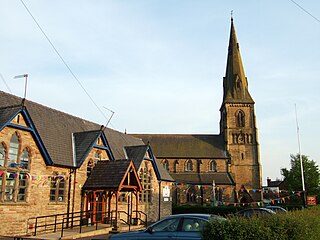
Tarleton is a village and civil parish in the borough of West Lancashire, Lancashire, England. It situated in the Lancashire mosslands approximately 10 miles north east of Southport, approximately 10 miles south west of Preston, approximately 10 miles west of the town of Chorley, and approximately 10 miles north of Ormskirk. The village is known for farming due to its rich soil quality. The River Douglas runs northwards to the east of the village, which is locally thought to be where the Vikings camped on the river banks of what is now Tarleton. The parish also includes the village of Mere Brow and the hamlets of Sollom and Holmes.
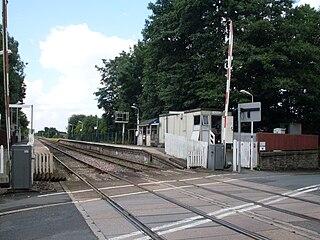
Rufford railway station, opened on 2 April 1849, serves the village of Rufford in Lancashire, England. The station is south west of Preston on the Preston-Ormskirk branch service. The line was formerly the Liverpool, Ormskirk and Preston Railway, which was quickly merged into the East Lancashire Railway on 3 August 1846; this in turn was merged into the Lancashire and Yorkshire Railway in May 1859.

Rufford is a village in West Lancashire, England, where the Leeds and Liverpool Canal, Liverpool, Ormskirk and Preston Railway, the A59 and the River Douglas meet.
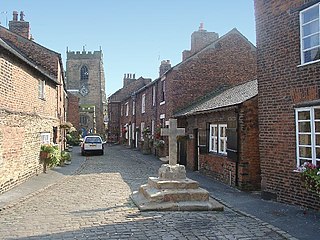
Croston is a village and civil parish near Chorley in Lancashire, England. The River Yarrow flows through the village. The population of the civil parish taken at the 2011 census was 2,917.

Rufford Old Hall is a National Trust property in Rufford, Lancashire, England. Built in about 1530 for Sir Robert Hesketh, only the Great Hall survives from the original structure. A brick-built wing in the Jacobean style was added in 1661, at right angles to the Great Hall, and a third wing was added in the 1820s.
The Ormskirk branch line is a railway line in Lancashire, England, running between Preston and Ormskirk. The train service is operated by Northern Trains, who usually operate class 150, 156, and 158 units. The line is the northern section of the former Liverpool, Ormskirk and Preston Railway; the line from Ormskirk to Liverpool is now part of Merseyrail's Northern Line. Prior to the introduction of the 1970–71 London Midland Region timetable, it was a secondary main line from Liverpool to Scotland, Blackpool, and Yorkshire. From 4 May 1970, however, the line was severed at Ormskirk. With express trains eliminated, stopping services at the village stations en route were improved, and have retained a similar frequency to this day.

Rufford Abbey is a country estate in Rufford, Nottinghamshire, England, two miles (4 km) south of Ollerton. Originally a Cistercian abbey, it was converted to a country house in the 16th century after the Dissolution of the Monasteries. Part of the house was demolished in the 20th century, but the remains, standing in 150 acres of park and woodland, are open to the public as Rufford Country Park. Part of the park is a local nature reserve.

Holmeswood is a small agricultural village in West Lancashire, in the north-west of England. It lies just north of the Martin Mere Wetland Centre and to the south of North Meols about six miles east of the Irish Sea coast at Southport.
Wombourne High School is a coeducational secondary school and sixth form located in Wombourne, Staffordshire, England. It is situated on Ounsdale Road in the west of the village, and stands on an adjacent site to the local leisure centre. It also has an Invictus sixth form base campus on site for 16- to 19-year-olds, which has a built 6th form centre detachment which was opened by the pop star Beverley Knight. The schools is currently undergoing building, this includes; New window fixtures, A secondary entrance to the reception area with a disabled ramp and stairs.
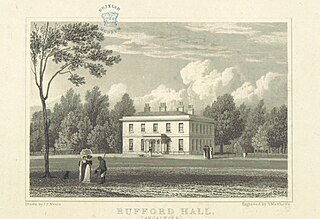
Rufford New Hall is a former country house that belonged to the Heskeths who were lords of the manor of Rufford, Lancashire, England. It replaced Rufford Old Hall as their residence in 1760. From 1920 to 1987 it was used as a hospital and has subsequently been restored and converted for residential use. It was designated a Grade II listed building in 1986.

Inkersall and Inkersall Green are areas of settlement in Derbyshire, England. They are located south of the A619 road, 4 miles (6 km) east of Chesterfield and close to Junction 29a of the M1 Motorway.

Sollom is a hamlet in the parish of Tarleton, in Lancashire, England. It lies south of Tarleton and north of Rufford on the A59 road, giving the village good links to Preston, Southport and Liverpool.

The Rufford Foundation, formerly the Rufford Maurice Laing Foundation, is a trust based in the United Kingdom that funds nature conservation projects by small or medium-sized organizations in developing countries.
Rufford is a civil parish in the West Lancashire district of Lancashire, England. It contains ten buildings that are recorded in the National Heritage List for England as designated listed buildings. Of these, one is listed at Grade I, the highest of the three grades, and the others are at Grade II, the lowest grade. The parish contains the villages of Rufford and Holmeswood, as well as the surrounding countryside. The most important building in the parish is Rufford Old Hall; this and associated structures are listed. The Rufford Branch of the Leeds and Liverpool Canal passes through the parish and a lock on it is listed. The other listed buildings include houses, a church and a cross base in the churchyard, and a public house.

The Association for Social and Environmental Development (ASED) is an Indian non-profit organisation headquartered in Kolkata, West Bengal, India and registered under Section 25 of the Indian Companies Act. It promotes nature conservation and an ecologically resilient society, and undertakes programmes for school students.

















